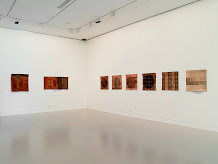The 'Lost birds series' incorporates (if that is the correct term for images which are 'missing') an image of the Glossy Black Cockatoo, Calyptorhynchus lathami from a watercolour by the colonial artist, George Raper. The original is in the British Museum.
My bird book (A Field Guide to the Birds of Australia by Graham Pizzey) suggests that 'glossy' is a misnomer, it is 'a dull-black cockatoo with a massive bulbous bill and red panel in tail'(author's italics).
Pamela tells of seeing the Glossy Black Cockatoo in the Wattagans, close to where she lives. We may also have them around here but they are easily mistaken for their more raucous cousins, the Red-Tailed Black Cockatoos which makes identification difficult.
They have a specific diet--the seeds of the casuarina trees and a specific feeding ritual--picking up each seed pod with one claw and passing it to the next before breaking it apart with its bill (PF pers.comm.).
Their numbers are declining, possibly due to the clearing of woodlands.
So so we contend with the possibility of real 'loss'.
Wednesday, April 28, 2010
Tuesday, April 6, 2010
The 'Lost Birds Series' (2006/7)
For the moment, it is this--the 'Lost birds series' (2006/7) that I will use as a basis of my presentation in October. Pamela has lent me seven of the series of eight (the eighth is in a private collection).
These are relatively small quilts, each approximately 19.5 cm x 19.5 cm and of plant-dyed and commercial silk, hand and machine stitched and backed with silk.
These are unusual works for Pamela for a number of reasons I intend to explore, yet they are instantly recognisable as her work. I find them extraordinarily beautiful, yet need time to understand why.
For now, I identify a sense of 'wonder' while acknowledging the process of analysis ('wondering') which will necessarily follow.
The repeating image, a silhouette of a cockatoo (the 'lost' bird in question) references a water colour by the early colonial artist, George Raper. The original painting is of a black cockatoo but I need to confirm which species of black cockatoo and also details of the original painting.
These are relatively small quilts, each approximately 19.5 cm x 19.5 cm and of plant-dyed and commercial silk, hand and machine stitched and backed with silk.
These are unusual works for Pamela for a number of reasons I intend to explore, yet they are instantly recognisable as her work. I find them extraordinarily beautiful, yet need time to understand why.
For now, I identify a sense of 'wonder' while acknowledging the process of analysis ('wondering') which will necessarily follow.
The repeating image, a silhouette of a cockatoo (the 'lost' bird in question) references a water colour by the early colonial artist, George Raper. The original painting is of a black cockatoo but I need to confirm which species of black cockatoo and also details of the original painting.
Subscribe to:
Posts (Atom)



